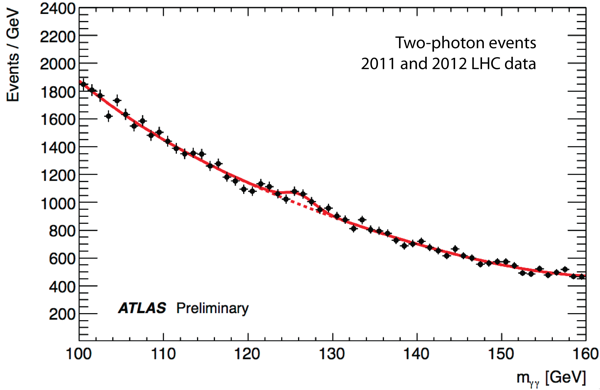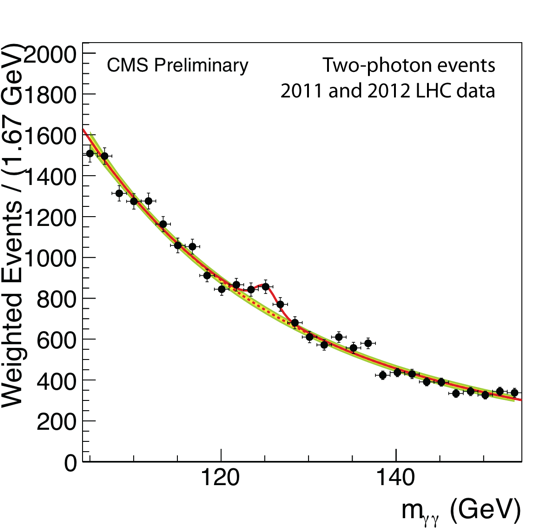Congratulations to Francois Englert and Peter Higgs for winning this year’s Nobel Prize in Physics. However annoying the self-imposed rules are that prevent the prize from more accurately reflecting the actual contributions, there’s no question that the work being honored this time around is truly worthy.
To me, the proposal of the Higgs mechanism is one of the absolutely most impressive examples we have of the precision and restrictiveness of Nature’s workings at a deep level — something that sometimes gets lost in the hand-waving analogies we are necessarily reduced to when trying to explain hard ideas to a wide audience. There they were, back in 1964 — Englert and Higgs, as well as Anderson, Brout, Guralnik, Hagen, and Kibble — confronted with a relatively abstract-sounding problem: how can you make a model for the nuclear forces that is based on local symmetry, like electromagnetism and gravity, but nevertheless only stretches over short ranges, like we actually observe? (None of these folks were thinking about “giving particles mass”; that only came in 1967, with Weinberg and Salam.)
It sounds like a pretty esoteric, open-ended question. And they just sat down and thought about it, with only very crude guidance from actual data. And they went out on a limb (one that had been constructed by other physicists, like Yochiro Nambu and Jeffrey Goldstone) and put forward a dramatic idea: empty space is filled with an invisible field that acts like fog, attenuating the lines of force and keeping the interaction short-range. How would you ever know that such an idea were true? Only because you could imagine poking that field a bit, to set it vibrating, and observe the vibrations as a new kind of particle.
And forty-eight years later, billions of dollars and thousands of dedicated people, that particle finally showed up, as a little bump amidst trillions of collision events. Amazing.

Here are my Top Ten Higgs Boson Facts. And here I am yakking about it on Sixty Symbols:
Professors Englert and Higgs have every reason to be very proud, but this prize is really a testament to human intellectual curiosity and perseverance. And well deserved, at that.

Great post. It’s a shame that Brout can’t be honored in the same way, and that Hagen, Kibble, and Guralnik (who, in all of my interactions with him at Brown, was remarkably humble about his contributions) are left out by virtue of being three people rather than one.
Pingback: Allgemeines Live-Blog ab dem 4. Oktober 2013 | Skyweek Zwei Punkt Null
Pingback: Higgs, Englert, and the Nobel Prize | Christian Ready
Regarding your sentence: None of these folks were thinking about “giving particles mass”… that does not seem accurate.
From Higgs’ original 1964 PRL verbatim: “It may be expected that when a further mechanism (presumably related to the weak interactions) is introduced in order to break Y conservation, one of these gauge fields will acquire mass, leaving the photon as the only massless vector particle.”
They were thinking about giving gauge bosons mass, sure — that was the whole point. But not the general idea of giving mass to all massive particles, in particular the fermions.
Indeed great congratulations for Higgs Englert et al, they really were ahead of their time and their ideas were and still are keystones for our thinking. The field idea is a wonderful concept , it has long before, in other concepts, been thought of as “ether” (mist, fog). The idea should have been given the Nobel prize 40 years ago. I wonder what happens in 2015 when the LHC is “powered” up and perhaps more direct results will become (or not) “visible”, and the Field will perhaps not only be thought of as a proof for the Standard Model.
From:
The Nobel Prize in Physics 2008- Presentation Speech by Lars Brink:
“…How is this reflected in the fundamental laws of nature, the ones
that govern physics at the smallest distances? When elementary
particles and the forces that act between them were studied in
experiments from the 1950s onward, it was found that everything that
the underlying symmetries allow can happen. Symmetries must therefore
impose enormously strong restrictions for the laws to be meaningful.
How can this lead to our universe, with its four kinds of fundamental
forces and great variety of elementary particles? The decisive idea
came from Yoichiro Nambu, who in 1960 showed that the fundamental
laws of nature can exhibit spontaneous broken symmetries, as
illustrated by the person falling off the Matterhorn. There can be
strong restrictions from large symmetries that are not seen directly
in physical experiments, at least at the energies that can be
produced in today’s large particle accelerators. The symmetries are
there as a consequence of the fundamental laws of physics, but for a
system in its ground state there are no direct signs of the
restrictions that symmetry should impose. This means, for instance,
that the electromagnetic force and the weak nuclear force do not
appear related, even though the underlying theory says so. This is
just one example of Nambu’s ideas that permeate all of modern physics
and have been tested in numerous experiments…”
—————————
For one of the papers that the award referenced see:
“Quasi-Particles and Gauge Invariance in the Theory of Superconductivity”
Yoichiro Nambu
Physical Review 117 (1960) p. 648-663
—————————-
Is your three facts in your article “Top Ten Higgs Boson Facts” still true today?
3. We’ve probably discovered the Higgs, but we’re not completely sure.
6. The Higgs boson isn’t really all that important.
8. Your own mass doesn’t come from the Higgs.
Awesome…
@Tienzen: absolutely. The explanations that Sean has for each of those points are still valid. In particular, point 3: are we sure its the Higgs? The LHC is currently not running. The physicists, engineers and technicians for the experiments (CMS, ATLAS, LHCb and ALICE) are all working on improving the detectors, while those for the LHC machine are working on improvements that will allow the energy of the LHC to be significantly increased. We hope to start data taking again in early 2015. With the improvements in the detectors and the increase in energy (as well as intensity), we will be able to produce more of the boson at 126 GeV to study it in more detail. While all signs at the moment point to it being the Higgs boson, there are still some properties that haven’t been fully probed.
@Dr Bob,
Thanks for the info. I thought that I have missed some new CERN reports after March 2013.
Well here’s my initial crack at trying to bring some more rigor into the explanation of how the Higgs mechanism works…
http://thefurloff.com/2013/10/11/just-what-does-this-higgs-thingy-do/
I enjoyed your great video-clip Sean.
All those credited or not credited for the Andersen-Higgs mechanism drew inspiration from the ideas of Andersen who came up with the whole thing. The only thing left to do was work out the math. Shouldn’t he also have deserved a share.
“the self-imposed rules”.
Wrong, I think. The prize follows a will. Any changes has to be modified according to law. (Or we wouldn’t have wills.)
When did people start to think of the Nobel Prize as a governmental (swedish) project?
Can you answer Sean my question please?
I’ve heard that the Higgs Boson was not totally confirmed, that there were some unchecked properties, is it true?
Thank you, I’m from Soudan.
Embaboué– it has been essentially confirmed. Nothing in science is ever 100%, and we are still open to being surprised by some property of the boson that we haven’t yet measured, but pretty much everyone accepts that it is a Higgs boson. (There might be more than one, which is why we say “a” rather than “the”, at least when we’re being careful.)